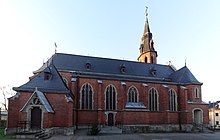St. Boniface (Apolda)
The Roman Catholic Church of St. Bonifatius in Apolda on Stobraer Straße is the center of the city's Catholic community and has been part of the Catholic parish of St. Johannes Baptist Jena in Thuringia since January 1, 2017 .
history
In 1884 a small Catholic parish had formed in Apolda. In 1886 a Catholic school was established where services were held. The premises were soon no longer sufficient for the growing community. Therefore, the responsible diocese of Fulda acquired a plot of land on Stobraer Strasse in 1892 for the construction of a church and a school and parsonage. On March 1, 1893, the building of the neo-Gothic, three-aisled hall church made of bricks, financed by collections, began. The architect was the archbishop's building director Max Meckel from Frankfurt am Main, and the building contractor was the master mason Eduard Seidel. The church was consecrated on September 30, 1894 .
After a 115-year history, the parish became part of the newly formed parish of St. Johannes Baptist in Jena on January 1, 2017.
Furnishing
The octagonal tower was built on the right side of the building and accommodated three bells, cast in 1897 in the Apolda bell foundry Ulrich . The tower itself is the second tallest structure in Apolda. However, the tower has a special feature, it does not have a clock.
The current design no longer corresponds completely to the time it was created. The church was modernized in various phases of renovation. However, the ornamental wooden ceiling of the central nave, the stalls, the confessionals, the baptismal font, the organ and the leaded glass windows have survived. The side aisles house the confessionals, the stations of the cross and the processional gallery.
The windows form a unique ornament, made by the Frankfurt glass painter I. Dröser.
The organ with 23 sounding stops comes from the organ and instrument builder Martin Joseph Schlimbach from Würzburg .
literature
- Ernst Fauer: The bells of the Catholic St. Bonifatius Church in Apolda . In: Apoldaer Geschichtsverein e. V. (Hrsg.): Apoldaer Heimat - Contributions to the nature and local history of the city of Apolda and its surroundings . Issue 12. Apolda 1994, p. 12-14 .
Web links
Individual evidence
- ^ History , accessed January 2, 2018
- ↑ meinapolda , accessed on January 2, 2018
Coordinates: 51 ° 1 ′ 21 ″ N , 11 ° 31 ′ 17.3 ″ E







